This article was published in Scientific American’s former blog network and reflects the views of the author, not necessarily those of Scientific American
If you read the previous article you’ll know that my aim here is to review (briefly) the diversity and evolutionary history of accipitriform raptors, the group that includes vultures, hawks, eagles and their kin. In this second article we look at the remaining groups, and we start with secretarybirds. These articles have been written because I’m currently compiling the enormous bird section of my still in-prep textbook… on which more here.
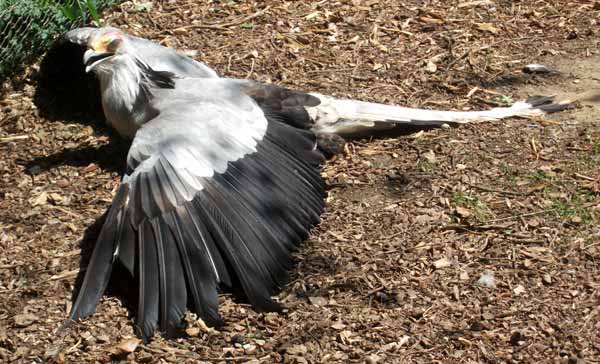
You might have seen this photo of a sun-bathing secretarybird before... Credit: Darren Naish
Anyway… it’s near-universally agreed that the Secretarybird Sagittarius serpentarius is closely related to Accipitridae (the group that includes Old World vultures, hawks and eagles): it shares behavioural features with them as well as egg characters and groups with them in molecular studies. Within the context of raptors as a whole, secretarybirds are not as exceptional as they might appear since we know that fossil raptors of two or three other lineages (all within Accipitridae) evolved a secretarybird-like way of life and morphology and were convergent with them in tarsometatarsal morphology. I’m not going to say any more on secretarybirds because the group was recently given the Tet Zoo treatment here.
On supporting science journalism
If you're enjoying this article, consider supporting our award-winning journalism by subscribing. By purchasing a subscription you are helping to ensure the future of impactful stories about the discoveries and ideas shaping our world today.
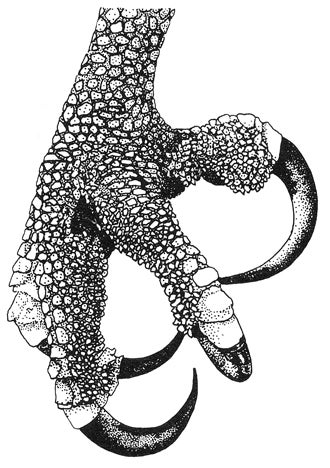
The brilliant semi-zygodactyl foot of an osprey. Credit: Poole 1989
The Osprey or Fish hawk Pandion haliaetus is a piscivorous raptor, distinctly marked in brown and white, and associated with lakes, coasts, marshes and (sometimes) rivers. It has a set of unusual features of the feet associated with fish-grabbing, including the ability to reverse the 4th toe (a condition known as semi-zygodactyly), spiny foot pads, and fast-twitch muscles that allow the foot to close in something like 20 milliseconds. The foot-first plunging behaviour and sometimes laboured take-off from the water surface can be spectacular, and there are many tales of ospreys drowning after grabbing hold of fishes too big for their size and strength. I particularly like the myths about gargantuan lake fishes – typically carp – said to swim about with the bones of decomposed ospreys still attached to their skin. Remarkably, a case of just such a thing was apparently verified in 1936 or 1937 in Magdeburg, Germany (Ferguson-Lees 1968). Alas, the unlucky bird proved to be a Common buzzard Buteo buteo, not an osprey at all. Oh, and… the association between the raptor and the fish was probably artificial (Cowles 1969). Aww, drat.
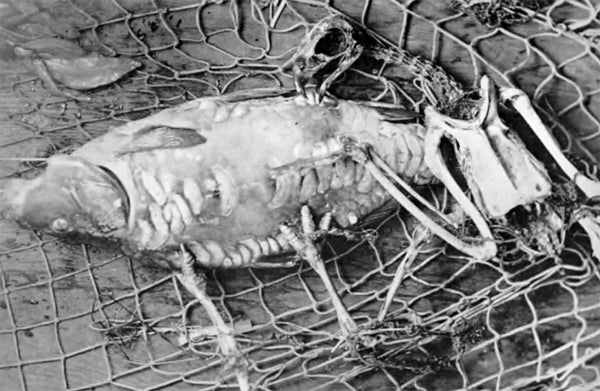
Oh wow, osprey vs fish, fish wins! But... NOPE (see text). Credit: Ferguson-Lees 1968
Ospreys are clearly very close to accipitrids, so much so that several workers have abandoned the use of a special ‘family’ status for Pandion (Pandionidae) and instead prefer to see it absorbed into Accipitridae. As is well known, ospreys are near-cosmopolitan, making P. haliaetus – the one species recognised by most experts – one of the most widely distributed bird species. Indeed, some experts have wondered why ospreys – as a group – are species-poor while other raptor groups that exploit a similar niche (sea eagles) have speciated extensively (Poole 1989).
However, the several ’subspecies’ recognised within the extant Pandion population are more distinct in genetic distance than are many other bird populations universally regarded as good’ species, so a case can be made that P. haliaetus is actually a species complex. The evidence for this was presented in a 2004 study (Wink et al. 2004) but hasn’t been the subject of further discussion, to my knowledge. Incidentally, the different osprey subspecies/species do hybridise in some places and there are reasons for thinking that eastern Palaearctic and North American ospreys have become more alike – due to hybridisation – since the end of the Pleistocene. Ospreys as a whole must be quite old: there are Miocene species of Pandion and Oligocene remains of indeterminate forms. Furthermore, the fact that ospreys are the sister-group to Accipitridae means that they must have diverged during the Eocene at least, since the accipitrid record appears to go back that far.
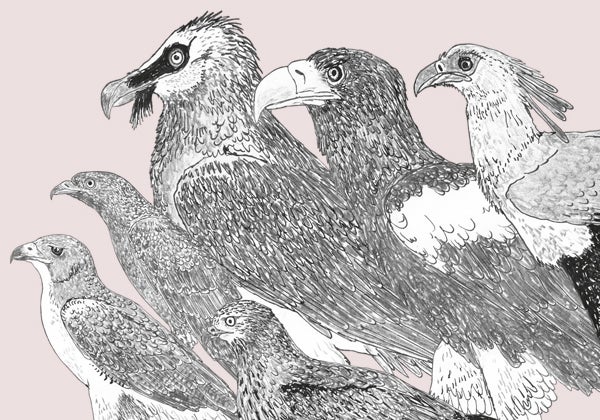
The accipitrid radiation is large and complex (oh, and a Secretarybird appears here at far right too); I’ve been illustrating members of all main lineages for my textbook and here are just some of them. Credit: Darren Naish
The accipitrid radiation is vast and complex and involves numerous groups conventionally identified as ’tribes’ or ‘subfamilies’. They are, variously, the elanoidine and elanine kites, the Old World vultures (Gypaetinae and Aegypiinae), the bazas, cuckoo-hawks and honey buzzards (Perninae), serpent eagles (Circaetinae), harpy eagles and kin (Harpiinae), harriers (Circinae), milvine kites, accipiter hawks, buteonine hawks and aquiline eagles, and weirdos that are difficult to place, like harrier-hawks or gymnogenes (Polyboroides), chanting goshawks (Melierax) and bathawks (Machaerhamphus).
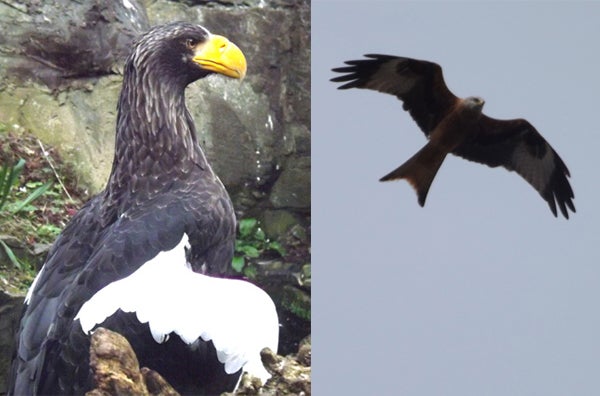
Sea eagles - like this awesome Steller’s sea eagle Haliaeetus pelagicus - are almost certainly not close kin of aquiline eagles, and may instead be close to milvine kites, like the Red kite Milvus milvus shown at right. Credit: Darren Naish
Views on how these groups might relate to one another vary somewhat from one study to the next, which is important if you want to work out probable ancestral states and lifestyles and reconstruct the probable pattern of evolution. However, morphological and molecular studies do agree on a few key points: elanine kites, serpent eagles and Old World vultures all diverged early within the history of the group and are outside a clade that includes harriers, accipiters and booted eagles (the buteonines and aquilines) (Holdaway 1994, Lerner & Mindell 2005, Griffiths et al. 2007, Barrowclough et al. 2014). ‘Kites’ are not monophyletic, the two Old World vulture groups (gypaetines and aegypiines) may or may not be close kin, serpent eagles may be the closest relatives of Old World vultures, milvine kites may be part of the accipiter, buteonine and aquiline group, and harriers may be deeply nested within Accipiter hawks. I always liked the idea that milvine kites and sea eagles might be close kin, in which case any similarity between sea eagles and aquiline eagles is convergent.
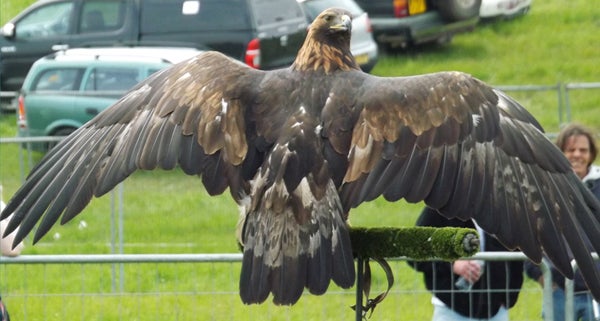
One of the 'ultimate' accipitrids: the widely distributed, mammal-killing Golden eagle Aquila chrysaetos. Credit: Darren Naish
And while, as usual, there’s tons more that could be said – especially as goes the complex history and evolution of the accipitrids – we must stop there. Next: the Tet Zoo 2018 birthday event.
For previous Tet Zoo articles on raptors, see...
Refs - -
Barrowclough, G. F., Groth, J. G., Lai, J. E. & Tsang, S. M. 2014. The phylogenetic relationships of the endemic genera of Austrao-Papuan hawks. Journal of Raptor Research 48, 36-43.
Cowles, G. S. 1969. Alleged skeleton of osprey attached to carp. British Birds 62, 542-543.
Ferguson-Lees, I. J. 1968. Skeleton of osprey attached to carp. British Birds 61, 465.
Griffiths, C. S., Barrowclough, G. F., Groth, J. G. & Mertz, L. A. 2007. Phylogeny, diversity, and classification of the Accipitridae based on DNA sequences of the RAG-1 exon. Journal of Avian Biology 38, 587-602.
Holdaway, R. N. 1994. An exploratory phylogenetic analysis of the genera of the Accipitridae, with notes on the biogeography of the family. In Meyburg, B.-U. & Chancellor, R. D. (eds) Raptor Conservation Today. WWGBP/The Pica Press, pp. 601-649.
Lerner, H. R. L. & Mindell, D. P. 2005. Phylogeny of eagles, Old World vultures, and other Accipitridae based on nuclear and mitochondrial DNA. Molecular Phylogenetics and Evolution 37, 327-346.
Poole, A. F. 1989. Ospreys: A Natural and Unnatural History. Cambridge University Press, Cambridge.
Wink, M., Sauer-Gurth, H. & Witt, H.-H. 2004. Phylogenetic differentiation of the Osprey Pandion haliaetus inferred from nucleotide sequences of the mitochondrial cytochrome b gene. In Chancellor, R. D. & Meyburg, B.-U. (eds) Raptors Worldwide. WWGB/MME, pp. 511-516.